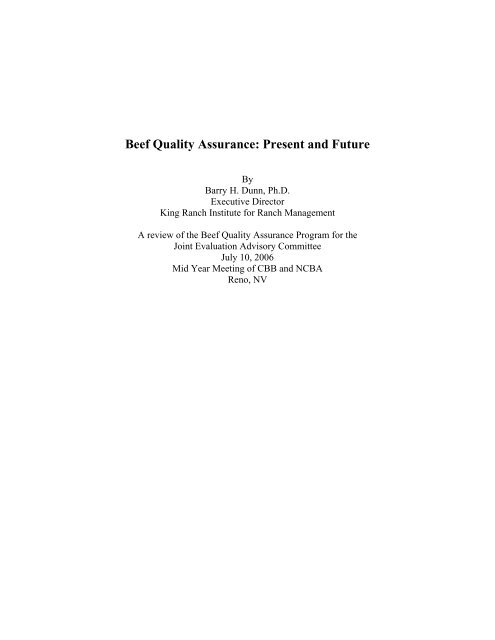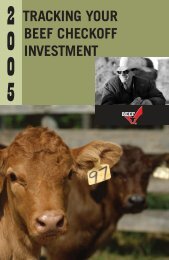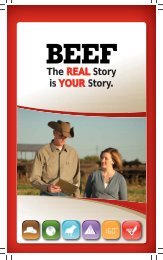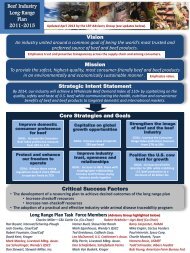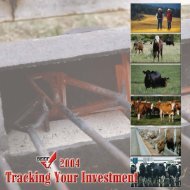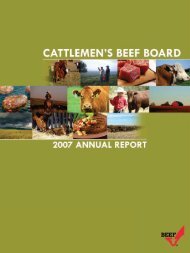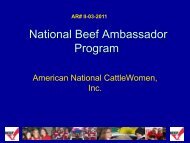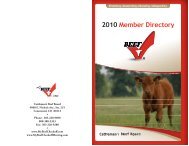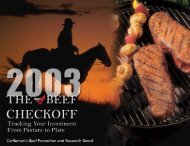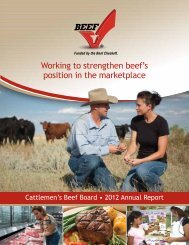Beef Quality Assurance: Present and Future - Cattlemen's Beef ...
Beef Quality Assurance: Present and Future - Cattlemen's Beef ...
Beef Quality Assurance: Present and Future - Cattlemen's Beef ...
You also want an ePaper? Increase the reach of your titles
YUMPU automatically turns print PDFs into web optimized ePapers that Google loves.
<strong>Beef</strong> <strong>Quality</strong> <strong>Assurance</strong>: <strong>Present</strong> <strong>and</strong> <strong>Future</strong>ByBarry H. Dunn, Ph.D.Executive DirectorKing Ranch Institute for Ranch ManagementA review of the <strong>Beef</strong> <strong>Quality</strong> <strong>Assurance</strong> Program for theJoint Evaluation Advisory CommitteeJuly 10, 2006Mid Year Meeting of CBB <strong>and</strong> NCBAReno, NV
2IntroductionThe purpose of this paper is to review the current status of the check-off funded <strong>Beef</strong><strong>Quality</strong> <strong>Assurance</strong> (BQA) program in the beef industry of the United States of America,its strengths <strong>and</strong> weaknesses, <strong>and</strong> to summarize possible directions it might take in thefuture. The opinions <strong>and</strong> positions are those of the author, as influenced by theindividuals <strong>and</strong> organizations interviewed, material <strong>and</strong> information researched <strong>and</strong>reviewed, <strong>and</strong> his personal experiences. It is not an evaluation of past programs. Theauthor has been in the cattle business his entire thirty-one year career, <strong>and</strong> hasparticipated in all phases of cattle production. He has served the industry in education,the promotion of the beef industry in various membership <strong>and</strong> leadership capacitiesincluding state cattlemen’s organizations, two terms on a state beef council, <strong>and</strong> innational beef organizations.MethodologyIn the preparation of this review, qualitative research techniques were used to gather <strong>and</strong>interpret information. The five major sources of information were:1. Personal Interviews2. Web search for resources, programs, <strong>and</strong> material3. Review of materials <strong>and</strong> programs4. Records <strong>and</strong> information from The Cattlemen’s <strong>Beef</strong> Board5. Comments <strong>and</strong> opinions gleaned from conversations <strong>and</strong> meetingsThe perspective taken by the author was one of an interested party who had someworking knowledge of the program, but did not know the intricate details of the history,or current operational status of the BQA program.<strong>Present</strong> Status <strong>and</strong> <strong>Future</strong> DirectionGeneral DescriptionIn 2006, BQA is a loose knit coalition of the Cattlemen’s <strong>Beef</strong> Board (CBB), NationalCattlemen’s <strong>Beef</strong> Association (NCBA), state beef councils, state cattlemen’sorganizations, industry partners, state <strong>and</strong> county Cooperative Extension Service (CES)personnel from across the country, state <strong>and</strong> federal regulators, <strong>and</strong> individualveterinarians, cattle feeders, <strong>and</strong> ranchers. Funding from The <strong>Beef</strong> Checkoff Program,provided by the Cattlemen’s <strong>Beef</strong> Board <strong>and</strong> state beef councils, has been the majorcatalyst for what has evolved into an industry wide program. It is largely an educationalprogram directed toward the production side of the beef industry to improve consumerconfidence. Its focus is on the correct use of animal health products, feed additives <strong>and</strong>supplements, prevention of disease, <strong>and</strong> the proper care <strong>and</strong> h<strong>and</strong>ling of livestock.Projects <strong>and</strong> educational activity involving live cattle are authorized by the Act <strong>and</strong> Orderprovided the objective of the project is to clearly enhance the quality, safety, <strong>and</strong>consumer acceptability of beef <strong>and</strong> beef products. According to NCBA staff, there iscurrently BQA programming activity in all 50 states <strong>and</strong> for the production systems of
3beef, dairy, <strong>and</strong> veal. Recommendations from BQA informational material <strong>and</strong> trainingfall into the broad categories of record keeping, management, product <strong>and</strong> animalh<strong>and</strong>ling <strong>and</strong> care, <strong>and</strong> sampling. There are certification processes available in somestates <strong>and</strong> in some industry segments. There are no verification or audit processes inplace relating to BQA practices actually being used by cattlemen in the production ofbeef. Perhaps the hallmark of the program is the adherence by all participants to theguiding principle that sound science will be the foundation of educational efforts toimprove beef cattle production in terms of providing a high quality product to consumers.The topic areas generally covered in BQA training <strong>and</strong> educational programs are:1. Feedstuffs & sources2. Feed additives & medications3. Animal health treatments & injections4. Record keeping5. Animal care <strong>and</strong> husb<strong>and</strong>ry practices6. Carcass qualityScopeDue to its organizational structure, the BQA program has the ability to reach into everycorner of the United States beef production system <strong>and</strong> touch a very high percentage ofindustry participants. It has evolved over the last twenty-five years from concern aboutresidues to a comprehensive discussion concerning all aspects of beef production acrossall segments of the industry. The program was formalized in 1991 with the use of dollarsfrom The <strong>Beef</strong> Checkoff Program. During this long period of time, the focus of theprogram has appropriately remained the health <strong>and</strong> well being of the consumer <strong>and</strong> theresponsibility of the producer.Segments of the industry1. <strong>Beef</strong>2. Dairy3. Veal4. Fed5. Non-fedThe author found it very difficult to actually measure BQA’s scope <strong>and</strong> penetration intoall segments of the industry. There are anecdotal reports on the number of trainings,meetings, publications, <strong>and</strong> certifications, but a centralized reporting system orinformation database does not exist. Several of the states where BQA is very active canprovide estimates, but many states can not. In the interviews conducted, positive resultsreported in the National <strong>Beef</strong> <strong>Quality</strong> Audit-2000 concerning injection site lesions werealmost always cited as evidence of the program’s activity <strong>and</strong> success. In the sameconversations, serious problems reported in the National Market Cow <strong>and</strong> Bull <strong>Beef</strong><strong>Quality</strong> Audit-1999 concerning BQA issues were not mentioned. Other measures ofactivity <strong>and</strong> scope could be dollars spent on BQA programs <strong>and</strong> activity or full timeemployees (FTE) dedicated to the program. However accessing these figures was verydifficult. In most states, the program has been institutionalized into the l<strong>and</strong> grant
4university system, the state beef councils, or cattlemen’s organizations to such a degreethat it is impossible to measure the amount of money spent or people dedicated to theeffort. Although the author did not contact representatives from every l<strong>and</strong> grantuniversity, everyone that he did mentioned that BQA was taught in their <strong>Beef</strong> Productionclasses in the Animal Science Curriculum. Additionally, many people mentioned thatBQA is taught in the curriculums of technical schools, other colleges <strong>and</strong> universitiesoffering Animal Science courses, 4-H programs, <strong>and</strong> in vocational agriculture classes inhigh schools. Again, accurate numbers of trainings, people trained, or certifications inBQA from most states or the nation do not exist. In conversations with representatives ofseveral large ranches, BQA has been incorporated into their employee training <strong>and</strong> ranchprotocol. The feedlot industry has been very active in promoting the program <strong>and</strong>incorporating its methods <strong>and</strong> principles. Several interviewees expressed concern aboutthe level of participation within the dairy segment of the beef industry. Additionally,web-based training is available from several states. But it is difficult to accuratelydetermine the total number people trained or certified, within states or segments of theindustry.New efforts in BQA that exp<strong>and</strong> its scope <strong>and</strong> effectiveness would include makingmaterial available in Spanish, additional web based resources, <strong>and</strong> delivery to a widerrange of audiences. These would include people of younger ages, different sizes <strong>and</strong>types of operations, <strong>and</strong> to non-traditional audiences like truck drivers.In summary, judging from conversations <strong>and</strong> website announcements, the author is underthe impression that a great deal of activity concerning BQA goes on each year <strong>and</strong> isplanned for 2006 <strong>and</strong> beyond. That would be hundreds, perhaps thous<strong>and</strong>s, of meetings<strong>and</strong> classes across the nation reaching thous<strong>and</strong>s of individuals. However, at this point intime, there is no methodology in place to accurately gauge the actual scope of theprogram.ParticipationThe BQA program is usually delivered by or in collaboration between the followingorganizations:1. Cooperative Extension Services2. State beef councils3. State or local cattlemen’s organizations4. Veterinarians5. Sale barns6. Feedlots7. Ranches8. Universities <strong>and</strong> colleges9. High School vocational programs10. 4-H clubs
5Traditional target audiences have included:1. Feedlot owners <strong>and</strong> workers2. Ranchers <strong>and</strong> ranch h<strong>and</strong>s3. Farmers who own cattle <strong>and</strong> their workers4. Owners <strong>and</strong> employees of dairies5. Veal operations6. Students<strong>Future</strong> audiences may be exp<strong>and</strong>ed to include truck drivers, hobby type owner operators<strong>and</strong> targeted groups participating in coordinated marketing programs.ActivityThe primary activity of the BQA program centers around general education of peopleinvolved in the production processes of beef <strong>and</strong> beef products. These activities includethe publication <strong>and</strong> distribution of educational materials, hosting meetings <strong>and</strong> trainings,<strong>and</strong> in several states, certification <strong>and</strong> re-certification. There is BQA activity in all fiftystates. At any given time, one can find BQA activity going on somewhere. Much of thetraining centers around times of key production activity, however meetings <strong>and</strong> trainingsare held during all months of the year.Cost <strong>and</strong> ExpendituresThe Cattlemen’s <strong>Beef</strong> Board annual expenditures on BQA since 2003 are:Year BQA Budget Actual Expenses2003 $600,000 $511,1822004 $457,000 $256,0662005 $363,000 $308,0472006 $209,000 $ 14,160 (as of 4-30-06)One of the BQA’s greatest successes is that to a large extent, its activities have beenabsorbed <strong>and</strong> institutionalized into the programs of its participating organizations at thelocal, state, <strong>and</strong> national level. No identifiable processes could be identified toaccumulate a record of the expenditures made on the program within states, across states,or between or within organizations. As a result, at this point in time there is no way toestimate the total dollars expended on the program for a year, period, state, region, acrossthe nation, or by organization. For example, to my knowledge, there is no way tocalculate the total dollars spent on BQA by the CES, or the veterinary profession, or evenby state beef councils.In summary, the total dollars expended on the program are incalculable. This is aproblem in terms of industry communication. For example, since there is no way tobegin to estimate the total resources expended on the program, it is difficult tocommunicate to interested parties the importance of the program to the industry.
6St<strong>and</strong>ardizationAs evidenced by the various educational material <strong>and</strong> programs that were reviewed <strong>and</strong>the people interviewed, the guiding principals of BQA <strong>and</strong> the majority of the educationalprograms <strong>and</strong> material are well understood <strong>and</strong> are very similar. However there areseveral differences in programs between states. The most pronounced difference is in thesingle level training that most states have adopted <strong>and</strong> the two tier training withcertification that several states have adopted. In addition, several states <strong>and</strong> segments ofthe industry have site plan requirements. At this time there are no required process auditsassociated with basic BQA training, certification, or site plan development by state or thenational BAQ organizations. However, producers of “organic beef” <strong>and</strong> several “naturalbeef” programs are required to have verified site plans <strong>and</strong> are subject to audits.In the interviews conducted for this review, one of the most discussed issues concernedwhether or not value based, differentiated, or niche beef companies would in the futurerequire BQA certification, verification, or audits <strong>and</strong> if they were instituted who would bethe responsible parties. While the majority of producers, <strong>and</strong> educators felt that, at leastto some degree, that this was inevitable, representatives of meat companies felt thatsupply <strong>and</strong> dem<strong>and</strong> issues would restrict BQA from rising to these levels.In order for the industry to meet the BQA mission of consumer confidence, it is theauthor’s opinion that the industry should adopt rigid st<strong>and</strong>ardized terms, definitions,processes, <strong>and</strong> reporting techniques relating to BQA.ImpactIn conversation, the most widely cited example of the positive impact of BQA programsrelates to the decrease in injection site blemishes as reported in the National Fed <strong>Beef</strong><strong>Quality</strong> Audit. But it is the author’s opinion that the most important impact of BQA hasbeen the unexpected outcome of creating an outst<strong>and</strong>ing model of collaboration ofdiverse <strong>and</strong> wide spread groups <strong>and</strong> organizations toward a common goal. It would beimpossible to quantify BQA’s contribution toward the dramatic increase in the consumerdem<strong>and</strong> for beef that the industry has enjoyed over the last eight years. However, frominterviews <strong>and</strong> comments, it is clear that due to BQA, industry participants at all levelstake ownership of that increase in consumer dem<strong>and</strong> across the industry. That in itself isviewed by this author as a tremendous accomplishment.In terms of specific impacts on management techniques <strong>and</strong> procedures outlined in theBQA material <strong>and</strong> training sessions, it would require an extensive <strong>and</strong> complex survey todetermine if BQA training has actually changed targeted behavior. While there isevidence that some things have changed, there is also evidence that some things have not.For example, industry wide, injection sites have moved from the rump to the neck <strong>and</strong>injection site blemishes in carcasses have been reduced. However, it would bespeculative to say that the frequency of rib br<strong>and</strong>s, or the presence of birdshot incarcasses, for example, have decreased due to BQA training <strong>and</strong> education.
7At this time, there are a limited number of examples of BQA being used to differentiateproduction processes which is then used to access specific markets.Strengths/WeaknessesExamples of the strengths of the program are:1. Funding for programs <strong>and</strong> activities from The <strong>Beef</strong> Checkoff Program haveserved as an industry catalyst2. Enthusiasm towards industry priorities has been created3. Buy-in from all segments is outst<strong>and</strong>ing4. <strong>Quality</strong> of training, materials, <strong>and</strong> general effort is high5. The program has proven to be dynamic6. The program is apolitical7. Support of industry partners is outst<strong>and</strong>ing8. Institutionalization of principals <strong>and</strong> programs has occurred9. The program is a source of innovation in education <strong>and</strong> beef productionExamples of the weaknesses of the program are:1. Reporting of activity is very limited2. Reporting of expenditures is very limited3. Reporting of FTEs allocated from partner organizations is very limited4. St<strong>and</strong>ardization of the calculation <strong>and</strong> reporting of impacts is lacking5. The organizational structure does not fit the importance of the mission6. Coordination is good but could be improved7. Given the importance of the mission, websites relating to BQA are outdated,inadequate, or difficult to access8. Re-certification is a problem exasperated by the dynamic nature of the program9. Clear underst<strong>and</strong>ing by all involved of what programs fit under the BQA umbrella<strong>and</strong> which do not.Some of the program’s strengths have actually caused some of its weaknesses. Forexample, while its organization around a focused objective <strong>and</strong> core principals is to becommended, its lack of organizational structure <strong>and</strong> accountability have created asituation where no one really knows what the program cost, what are the cumulativeactivities or what are clearly identifiable impacts. Those deeply involved in BQAprogramming activity make an erroneous assumption that their mission, organizationalstructure, <strong>and</strong> activities are transparent, easily accessed <strong>and</strong> well understood by anyoneinterested in the program. The result of this lack of structure manifests itself in ways thatshould concern industry leadership. For example, websites related to BQA are generallyoutdated, hard to find, <strong>and</strong> confusing without a fairly sophisticated knowledge of theorganization of the industry. Also, BQA means different things to people from differentsegments of the industry. To the Cattlemen’s <strong>Beef</strong> Board, BQA refers to projects fundedby monies from The <strong>Beef</strong> Checkoff Program. To grassroots cattlemen, veterinarians, <strong>and</strong>educators, BQA means a comprehensive educational program. Many of those involved atthe grassroots level do not know, underst<strong>and</strong>, or seem to care about funding sources,requirements of the Act <strong>and</strong> Order, or other administrative distinctions or requirements.Their attitude is a commendable, spirited <strong>and</strong> enthusiastic “let’s get ‘er done.” However,it is the author’s opinion that the lack of organizational structure will be a serious
8problem as the industry works with governments, its partners, <strong>and</strong> its adversaries onissues like disease, health <strong>and</strong> safety, <strong>and</strong> the issues of animal identification, welfare, <strong>and</strong>husb<strong>and</strong>ry.A second example of a strength also being a weakness is the dynamic nature of theprogram. Being dynamic allows for the training to be continually updated <strong>and</strong> improvedas topics <strong>and</strong> issues emerge. However, re-certification <strong>and</strong> re-training levels across thecountry remain very low, <strong>and</strong> the author received numerous comments from cattlementhat follow-up training was not necessary because they had already been to BQA training.As emerging issues <strong>and</strong> topics like animal h<strong>and</strong>ling <strong>and</strong> welfare are added to the training,many cattlemen will be left out. In the future, diffusion <strong>and</strong> adoption levels of pasttopics, ideas, <strong>and</strong> concepts will be hard to match.Unexpected OutcomesAt all levels, the success of BQA projects funded by The <strong>Beef</strong> Checkoff Program <strong>and</strong> theeffectiveness of BQA educational programming have surprised people with a series ofunexpected positive results. Examples are:1. BQA has served as an excellent example of the positive impact of The <strong>Beef</strong>Checkoff Program2. It is a positive role model for educational efforts in the industry3. It is a positive role model for collaboration <strong>and</strong> cooperation4. It has allowed for the dissemination of additional information on other topicsThe author believes that these are testament to the outst<strong>and</strong>ing leadership of keyindividuals. Those would include Dr. Gary Cowman, former Vice President of theNational Cattlemen’s <strong>Beef</strong> Association, <strong>and</strong> the entire <strong>Quality</strong> <strong>Assurance</strong> AdvisoryBoard.<strong>Future</strong>While prognostications are difficult, based on past accomplishments <strong>and</strong> present trends,the following are offered as reasons why the future of the program is both bright <strong>and</strong>challenged.The future of BQA will be bright because of:1. Industry wide <strong>and</strong> extremely positive feelings towards BQA projects <strong>and</strong>activities funded by The <strong>Beef</strong> Checkoff Program2. Perceived effectiveness3. Perceived low cost4. Well understood mission5. Collaborative spirit of partners6. Dynamic nature allows adaptability <strong>and</strong> continues industry relevance7. Consensus based governance
9The future of BQA is challenged because of:1. A lack of sufficient organizational structure given its size <strong>and</strong> importance2. A lack of overall accountability3. A lack of reporting <strong>and</strong> accounting processes4. A failure to adequately document impacts5. Inadequate staffing, especially at NCBA6. The reliance of the program on the Cooperative Extension Service <strong>and</strong> largeanimal veterinarians as a critical part of the program delivery, given theirdeclining roles in rural America.7. The dynamic nature of the program makes the issues of re-training <strong>and</strong> recertificationcritical as past participants will not be exposed to current topics.The consensus of those surveyed was that in the future, the program will remainprimarily educational in nature. While discussed, there is little evidence that the programwill evolve into one with verification or audit processes that would document BQApractices on ranches. The exception will be when BQA is incorporated into requiredprocesses for specific marketing programs.The author believes that the rewards for participation will remain at the industry level.Even if the cattle market emerges into a two tiered market with cattle either fitting intoprocess verified (which might include BQA certification), the rewards for participationare most likely to be part of the differentiation of the marketplace <strong>and</strong> will not befunneled directly to individual participants.In the future, the costs of the program will remain minimal given its importance <strong>and</strong> howit has become institutionalized in the veterinary profession <strong>and</strong> the CES. However, therecommendations found in this paper to adequately staff the program, st<strong>and</strong>ardize itsprocesses, <strong>and</strong> to develop a reporting process will require national funding levels typicalof several years ago. If these are not achieved, the health, vitality, <strong>and</strong> effectiveness ofthe program are threatened. Participants have proven to be willing to pay for somematerial <strong>and</strong> training. However, the CBB, NCBA, <strong>and</strong> state beef councils are encouragedto rededicate funding to the program.ConclusionThe famous chef, Julia Childs, once unapologetically explained that many of the basicprocesses that she used in her cooking were critical for success because; “It’s just the wayyou cook!” Due to exceptional leadership at the national, state <strong>and</strong> local level <strong>and</strong> acrossmultiple organizations, BQA has risen to meet Julia Child’s mantra. For the widemajority of cattlemen, the principals of BQA have become “Just the way you raisecattle!” This is a tremendous accomplishment <strong>and</strong> many thanks are owed to manyhardworking <strong>and</strong> dedicated people.
With that said, as the old saying challenges; “what’s good for the goose is good for theg<strong>and</strong>er.” If record keeping <strong>and</strong> accountability are important for cattle producers, thenthey should also be important components of all levels of BQA programming. This willmean the rededication of resources, change in the organizational structure of the program,continual full staffing, <strong>and</strong> a renewed industry wide commitment to the fundamentalprincipal of gaining <strong>and</strong> keeping consumer confidence in beef. It is the strong opinion ofthe author that if the challenges outlined in this paper are not addressed; the past successof BQA will be extremely difficult to match, concerning issues critical to the future of thebeef industry. The best of BQA qualities <strong>and</strong> characteristics should be used as afoundation to meet the challenges of the dynamic beef industry.10
11AppendixPeople interviewed, visited with, or whose remarks were noted from meetings.1. Clayton Huseman, KLA, KS2. Kim McCuistion, TCES,TX3. Dr. Cody Wright, SDSU, SD4. Dr. Dan Kniffen, PSU, PA5. Dr. Dee Griffen, UNL, NE6. Dr. Ran Smith, Smith Cattle Co., KS7. Brian Bertelson, USPB, KS8. Dr. Darryl Strobehn, ISU, IA9. Dr. Paul Genho, FMC, UT10. Lisa Pederson, NDSU, ND11. John Braley, NCBA, CO12. Renee Lloyd, NCBA, CO13. Dr. Larry Corah, CAB, KS14. Dr. Tom Woodward, TX15. Dr. Craig Payne, MO16. Clint Richardson, DL&C, FL17. Wayne Fahsholtz, Country Natural <strong>Beef</strong> & Padlock Ranch, WY18. Dee Potter, UM, ME19. Travis Hoffman, CSU, CO20. Dr. Billy Robinson, LA21. Dr. Ron Leminager, Purdue University, IN22. Dr. Connee Quinn, Elanco, NE23. Matt Etheredge, King Ranch, TX24. David Genho, TX25. Bill Miller, USPB, KS26. Jerry Yates, WV
13The purpose of this paper is to provide an evaluation of the U.S. <strong>Beef</strong> <strong>Quality</strong><strong>Assurance</strong> Program, <strong>and</strong> to provide recommendations for future direction. The authorwas asked by the Joint Evaluation Advisory Committee consisting of members of theCattlemen’s <strong>Beef</strong> Board, <strong>and</strong> federation <strong>and</strong> policy divisions of National Cattlemen’s<strong>Beef</strong> Association (NCBA). Check-off funded BQA projects involving live cattle areauthorized provided that the objective of the activity is clearly to enhance the quality,safety <strong>and</strong> consumer acceptability of beef <strong>and</strong> beef products. The author used acombination of telephone interviews, face-to-face conversations, beef quality assurancematerials from a number of states, reports of the beef quality audits <strong>and</strong> his own personalknowledge <strong>and</strong> experience to evaluate <strong>and</strong> make recommendations.The first beef quality assurance program in the U. S. began in 1986. Thisprogram was developed by the National Cattlemen’s Association in response to concernsabout diet-health issues, hormones <strong>and</strong> potential residues 1 . The National Cattlemen’sAssociation (now the National Cattlemen’s <strong>Beef</strong> Association) <strong>Beef</strong> <strong>Quality</strong> Task Force in1990 began to address concerns raised about lesions resulting from injections of animalhealth products. An injection-site audit system was put in place to measure the incidence<strong>and</strong> size of injection-site lesions, <strong>and</strong> to determine the progress made in reducing theincidence <strong>and</strong> size 2 . Secondly, research was conducted to better define the causes ofinjection-site lesions. Injection-site lesions were found to be a result of the injection ofanimal health products into the muscle of cattle. These lesions were not only the result ofinjections given near the time of slaughter, but also occurred when the injections wereadministered over one year prior to slaughter 3 . The injections resulted not only invisually observed lesions in carcasses, but the injections resulted in decreased tendernessin the area around the detectable lesion 4 . Undesirable flavors were identified in lesionedareas of beef 5 . Injection-site lesion incidence has also been evaluated in beef <strong>and</strong> dairycows 6 . Additionally, an education program, using the BQA network, with particularemphasis on shifting location of intramuscular injections from top butt to the neck, wasimplemented. The progress made from 1991 to 2000 was remarkable. The incidence ofinjection-site lesions decreased from 21.3% in July of 1991 to 2.06% in July of 2000 2,5,7 .There is no doubt that the BQA Program deserves credit for leading the industryto the “near elimination” of a major problem with injection-site lesions/damage in thetop butt of cattle. The combination of audits that measured the incidence <strong>and</strong> magnitudeof the problem, research to further define the problem <strong>and</strong> its causes, <strong>and</strong> education thatwas broadly delivered by the BQA Program network including NCA <strong>and</strong> NCBA staff,state BQA coordinators, extension personnel, veterinarians <strong>and</strong> allied industry resulted inthis progress. This is a stellar example of the effective use of the principles of Total<strong>Quality</strong> Management.While progress on the injection-site issue has been impressive, the loss of thisissue as a “rallying point” for BQA has caused some reduction in energy <strong>and</strong> focus forthe program. Injection-site lesions were an easily communicated problem, <strong>and</strong> witheffective visual communication, producers could see the need to change practices.
14Today, the BQA Program has national leadership at NCBA, <strong>and</strong> the BQAnetwork includes active programs in over 40 states. The program is largely focused onbeef quality defined as “safety, wholesomeness <strong>and</strong> quality of beef”. This model hasbeen in place for several years. The periodic <strong>Beef</strong> <strong>Quality</strong> Audits provide much of theinformation used in the educational effort that is primarily carried out in state programs.The mission statement of the BQA Program is “to maximize consumer confidence in <strong>and</strong>acceptance of beef by focusing the industry's attention on beef quality assurance throughthe use of science, research <strong>and</strong> educational initiatives”. The national BQA guidelinesaddress five topics: 1) feedstuffs; 2) feed additives <strong>and</strong> medications; 3)processing/treatment <strong>and</strong> records; 4) injectable animal health products; <strong>and</strong> 5) care <strong>and</strong>husb<strong>and</strong>ry practices 8 . Also included in the <strong>Beef</strong> <strong>Quality</strong> <strong>Assurance</strong> Program website areguidelines covering <strong>Quality</strong> <strong>Assurance</strong>: Herd Health Plan, a Producer’s Guide forJudicious Use of Antimicrobials in Cattle, <strong>and</strong> Recommendations for Care <strong>and</strong> H<strong>and</strong>lingof <strong>Beef</strong> Cattle 8The BQA Program has had a BQA Task Force, now called the <strong>Beef</strong> <strong>Quality</strong><strong>Assurance</strong> Advisory Committee since inception. This Committee has several memberswith many years of service. The Advisory Committee has guided that development <strong>and</strong>implementation of the BQA Program. The fact that many individuals have long servicewith this group has contributed to stability <strong>and</strong> continuity for the program. StateCoordinators for BQA are in general extension personnel or staff at state cattleassociations or beef councils.There is considerable amount of variation in programs at the state level. In fact,there is criticism by some that there is too much variation in the programs at the statelevel. Critics express the concern that if too many topics or subjects that are distantlyrelated to beef quality get lumped under the BQA umbrella, the program loses focus,becomes diluted, <strong>and</strong> over time loses its value. Others argue that states are different, <strong>and</strong>need flexibility to meet the needs of their state. Currently, BQA Programs exist in over40 states 9 .The state of Montana has a Bovine Virus Diarrhea-Persistent Infection (BVD-PI)screening project as part of their <strong>Beef</strong> <strong>Quality</strong> <strong>Assurance</strong> Program. The project isdesigned to: 1) gauge the prevalence of BVD-PI in the state; 2) demonstrate innovativescreening/diagnostic techniques; <strong>and</strong> 3) investigate the economics of BVD-PI eliminationon a herd-by-herd basis. The components of the program are education, diagnosis,biosecurity <strong>and</strong> benefits 10 . This program is funded with federal congressionally directed(earmark) funds 11 .The South Dakota <strong>Beef</strong> <strong>Quality</strong> <strong>Assurance</strong>/Critical Management Plan is quitedifferent from most states 12 . The objectives of the South Dakota program are:1. To assure due diligence <strong>and</strong> best methods of production for food safety arepracticed by participating beef producers.2. To provide a model minimum uniform educational requirements to be completedby participating producers.
153. To provide a model minimum uniform critical management plan to be adopted byparticipants.4. To provide a model uniform national system for certification of beef producers instates participating in, <strong>and</strong> adhering to, these guidelines <strong>and</strong> minimum st<strong>and</strong>ards.5. To provide a model uniform national certification system recognized byproducers, state <strong>and</strong> national regulatory authorities, packers <strong>and</strong> producers,distributors <strong>and</strong> retailers, <strong>and</strong> consumers.The South Dakota <strong>Beef</strong> <strong>Quality</strong> <strong>Assurance</strong>/Critical Management Program appears tohave more emphasis on the food safety aspect of quality assurance. Perhaps this isbecause the program has been in part funded by USDA-FSIS.Most state programs do appear to focus their educational efforts on the topics ofthe national BQA guidelines. <strong>Beef</strong> <strong>Quality</strong> <strong>Assurance</strong> certification is focus of nearlyevery state program. There are over 65,000 producers currently certified in <strong>Beef</strong> <strong>Quality</strong><strong>Assurance</strong> 13 . In some states, there has been considerable emphasis on value-added calfprograms, <strong>and</strong> in others, on the proposed National Animal Identification System. Whileanimal identification <strong>and</strong> record keeping are important parts of <strong>Beef</strong> <strong>Quality</strong> <strong>Assurance</strong>Programs, the National Animal Identification System (NAIS) is not. The objective ofNAIS is to provide 48-hour traceback of animals for the purpose of disease control <strong>and</strong>eradication. “Lumping” NAIS into beef quality assurance creates confusion <strong>and</strong> puts<strong>Beef</strong> <strong>Quality</strong> <strong>Assurance</strong> programs at risk. NAIS is funded by USDA-APHIS, not beefcheckoff dollars.While funds from the <strong>Beef</strong> Checkoff Program support the effort at the nationallevel, there are many sources of funds at the state level. Most states have at least somefunds from their state beef councils. In many states, cooperative extension is funding thesalaries of many of the people conducting the state programs. Other sources of funds forindividuals conducting BQA programs include state beef councils, USDA-FSIS, USDA-APHIS, federal earmarks, “tobacco” money, <strong>and</strong> private industry. It appears that thevariation in state programs is at least in part due to the various sources of money. If onelooks at the total dollars invested in <strong>Beef</strong> <strong>Quality</strong> <strong>Assurance</strong>, it is likely that funds fromthe <strong>Beef</strong> Checkoff Program provide less than 20% of the total.A number of years ago, dairy-beef became an area of emphasis of BQA. Therecontinues to be a need in the dairy-beef area, especially since most violative residues ofanimal health products occur in dairy cattle 14 .The beef industry has changed a great deal since the first <strong>Beef</strong> <strong>Quality</strong> <strong>Assurance</strong>program was developed. Do changes in the industry change the information needs, or thestructure most capable of serving the beef industry?While <strong>Beef</strong> <strong>Quality</strong> <strong>Assurance</strong> has always been defined more broadly than qualitygrade, USDA quality grades are certainly one measure of beef quality.
16There are currently 43 USDA Certified <strong>Beef</strong> Programs. These programs havespecifications for live animal requirements including phenotype <strong>and</strong> genotype, qualityfactors, yield factors <strong>and</strong> carcass characteristics 15 . Certified Angus <strong>Beef</strong> is by far thelargest of these programs. In excess of 500 million pounds has been sold under theCertified Angus <strong>Beef</strong> br<strong>and</strong> for each of the last seven years 16 . While Certified Angus<strong>Beef</strong> has grown significantly <strong>and</strong> the percentage of cattle that are black has increased,quality grade has not increased. The 2005 National <strong>Beef</strong> <strong>Quality</strong> Audit adjusted the datafor the percentage of cattle graded, <strong>and</strong> reported that the percentage prime has declined1% <strong>and</strong> the percentage choice has declined 6.2% from 1975 to 2005 17 . Perhaps moresignificantly, a paper recently published by Corah <strong>and</strong> McCully (2006) 18 indicates thatthe recent decline in percentage of cattle grading choice has been significant. Theseauthors report information from the VetLife Benchmark Performance Program indicatingthat the percentage of heifers grading choice has declined from just over 58% in 1999 toless than 54% in 2005. Likewise, the percentage of steers grading choice has declinedfrom about 48% to about 44% during the same time period. This database representsover 10 million head <strong>and</strong> is the best industry database for evaluating this trend. Thedecline in quality grade is a huge problem in the industry, <strong>and</strong> requires immediateattention.Another change is the growth in the amount of beef sold under a br<strong>and</strong>. In 1986,only a small amount of U.S. beef was sold under a br<strong>and</strong>. In 2004, approximately 42%of retail beef was sold under a supplier or store br<strong>and</strong>. There is little doubt that thegrowth in br<strong>and</strong>ed beef has contributed to increased “quality” of product delivered to theconsumer, <strong>and</strong> ideally, quality is best defined at the consumer level. Br<strong>and</strong>ed beefgrowth <strong>and</strong> the supply systems that provide the product for br<strong>and</strong>s should drive the“quality” message throughout the supply chain. This is especially true for br<strong>and</strong>s thatreach all the way to the cow-calf sector of the industry to satisfy their animal <strong>and</strong> productspecifications.Good examples of these br<strong>and</strong>s are the natural “never-ever” br<strong>and</strong>s, which are bydefinition, source verified. These are br<strong>and</strong>ed beef programs that do not allow the use ofeither antibiotics or growth-promoting implants. The <strong>Beef</strong> Export Verification Program 19<strong>and</strong> associated <strong>Quality</strong> System Assessment Programs hold potential for driving “quality”through the supply chain. There is no doubt that Market Driven opportunities to improve“quality” work, <strong>and</strong> should be facilitated <strong>and</strong> exploited.While this industry has changed in the last 15 years, it is still largely a segmentedindustry. While br<strong>and</strong>s have grown significantly, only a small portion of the cow-calfsector is directly connected to a br<strong>and</strong> that drives decision making at the ranch level.Recommendations1. Maintain a <strong>Beef</strong> <strong>Quality</strong> <strong>Assurance</strong> program.
17The US beef industry should have a <strong>Beef</strong> <strong>Quality</strong> <strong>Assurance</strong> Program that is focusedon continually improving the products that the industry produces <strong>and</strong> the processes that ituses.2. Develop a strategic plan for <strong>Beef</strong> <strong>Quality</strong> <strong>Assurance</strong> for the US beef industry.It appears that this is a good time for the development of a strategic plan for <strong>Beef</strong><strong>Quality</strong> <strong>Assurance</strong>. This plan should be an important component of the beef industrylong-range plan. The planning process should include input from key stakeholdersincluding Cattlemen’s <strong>Beef</strong> Board, National Cattlemen’s <strong>Beef</strong> Association, <strong>Beef</strong> <strong>Quality</strong><strong>Assurance</strong> Advisory Board <strong>and</strong> state <strong>Beef</strong> <strong>Quality</strong> <strong>Assurance</strong> coordinators. I recommenda thorough evaluation of the current mission statement….. “to maximize consumerconfidence in <strong>and</strong> acceptance of beef by focusing the industry's attention on beef qualityassurance through the use of science, research <strong>and</strong> educational initiatives”. The missionstatement <strong>and</strong> goals should delineate the scope <strong>and</strong> reach of the program. Central to theplan is a clearly stated definition of beef quality. The plan must also include measurable,well-defined goals. It should be understood that the purpose is not only to develop aclear plan for <strong>Beef</strong> <strong>Quality</strong> <strong>Assurance</strong>, but to attain broad support for the plan.3. Ensure that the <strong>Beef</strong> <strong>Quality</strong> <strong>Assurance</strong> has strong leadership at the nationallevel.It is doubtful that a good plan can be successfully developed or implemented withoutstrong national leadership at the NCBA level. I encourage the organization to ensure thatthe leadership is in place.4. Continue the <strong>Beef</strong> <strong>Quality</strong> Audits.While the objectives of the <strong>Beef</strong> <strong>Quality</strong> Audits may change with changes in theindustry, the need to measure parameters that affect beef quality, <strong>and</strong> to benchmarkindustry progress does not change. I would recommend that the audits quantitativelyexamine not only changes that occur in the product(s), but measure changes in theindustry that affect beef quality, including live animal factors.5. Make <strong>Beef</strong> <strong>Quality</strong> <strong>Assurance</strong> (or components of BQA) market driven.Let me concede that this is much easier said than done. However, there is no doubtthat progress towards any significant objective will occur more rapidly when driven bythe market place. This is historically difficult in a highly segmented business, wheremarket signals are cloudy.6. Continue to Invest in Dairy-<strong>Beef</strong> <strong>Quality</strong> <strong>Assurance</strong>.Dairy-<strong>Beef</strong> should remain an important area of emphasis for the <strong>Quality</strong> <strong>Assurance</strong>,particularly because of the risk of violative residues in this group.
18Literature Cited1. Cowman, G. L. Personal Communication.2. Dexter, D.L., G.L. Cowman, J.B. Morgan, R.P. Clayton, J.D. Tatum, J.N. Sofos, G.R.Schmidt, R.D. Glock <strong>and</strong> G.C. Smith. 1994. Incidence of injection-site blemishes inbeef top sirloin butts. J. Anim. Sci. 72:824.3. George, M.H., P.E. Heinrich, D.R. Dexter, J.B. Morgan, K.G. Odde, R.D. Glock, J.D.Tatum, G.L. Cowman <strong>and</strong> G.C. Smith. 1995. Injection-site lesions in carcasses of cattlereceiving injections at br<strong>and</strong>ing <strong>and</strong> weaning. J. Anim. Sci. 73:3235.4. George, M.H., J.B. Morgan, R.D. Glock, J.D. Tatum, G.R. Schmidt, J.N. Sofos, G.L.Cowman <strong>and</strong> G.C. Smith. 1995. Injection-site lesions: incidence, tissue histology,collagen concentration, <strong>and</strong> muscle tenderness in beef rounds. J. Anim. Sci. 73:3510.5. George, M.H., G. L. Cowman, J.D. Tatum <strong>and</strong> G.C. Smith. 1996. Incidence <strong>and</strong> sensoryevaluation of injection-site lesions in beef top sirloin butts. J. Anim. Sci. 74:2095.6. Roeber, D.L., R.C. Cannell, W.R. Wailes, K.E. Belk, J.A. Scanga, J.N. Sofos, G.L.Cowman <strong>and</strong> G.C. Smith. 2002. Frequencies of injection-site lesions in muscles fromrounds of dairy <strong>and</strong> beef cow carcasses. J. Dairy Sci. 85:532.7. Roeber, D.L., R.C. Cannell, K.E. Belk, J.A. Scanga, G.L. Cowman <strong>and</strong> G.C. Smith.2001. Incidence of injection-site lesions in top sirloin butts. J. Anim. Sci. 79:2615.8. The National <strong>Beef</strong> <strong>Quality</strong> <strong>Assurance</strong> National Guidelines.http://www.beefusa.org/prodqualityassurance_bqa_.aspx9. <strong>Beef</strong> <strong>Quality</strong> <strong>Assurance</strong> State Coordinators.http://www.beefusa.org/prodstatecoordinators.aspx10. Paterson, John <strong>and</strong> Clint Peck. 2006. Montana BVD-PI Herd Screening Project-Montana <strong>Beef</strong> <strong>Quality</strong> <strong>Assurance</strong> Program.11. Peck, Clint. Personal Communication.12. South Dakota <strong>Beef</strong> <strong>Quality</strong> <strong>Assurance</strong>/Critical Management Plan.http://www.state.sd.us/aib/certification.htm13. Ruppert, Ryan, Director of <strong>Quality</strong> <strong>Assurance</strong> Programs, National Cattlemen’s <strong>Beef</strong>Association. Personal Communication.14. USDA-FSIS Residue Violators Alert List.http://www.fsis.usda.gov/PDF/Residue_Violators_List.pdf15. USDA Certified <strong>Beef</strong> Programs.http://www.ams.usda.gov/lsg/certprog/speccomp.pdf.16. Certified Angus <strong>Beef</strong>. http://www.cabpartners.com/facts/index.php.17. Smith, G.C., J.W. Savell, J.B. Morgan <strong>and</strong> T.E. Lawrence. 2005 National <strong>Beef</strong> <strong>Quality</strong>Audit.18. Corah, Larry <strong>and</strong> Mark McCully. 2006. Declining <strong>Quality</strong> Grades: A Review of FactorsReducing Marbling Deposition in <strong>Beef</strong> Cattle.http://www.cabpartners.com/news/research/index.php19. USDA Export Verification Program. http://www.ams.usda.gov/lsg/arc/bev.htm
19Review of BQA “White Papers”Paul Genho, Ph. D.June 29, 2006At the request of the Joint Evaluation Advisory Committee, I have reviewed the papers ofDr. Ken Odde <strong>and</strong> Dr. Barry Dunn dealing with the checkoff-funded <strong>Beef</strong> <strong>Quality</strong><strong>Assurance</strong> program. The methodology used in evaluating these papers was to 1) reviewthe methodology used by the authors in developing these papers 2) identify commonalityin their observations <strong>and</strong> recommendations <strong>and</strong> 3) test these recommendation against thethoughts of a small group of industry leaders. Finally some limited additionalrecommendations gleaned from those to who I talked will be proffered.It needs to be stated up front that these gentlemen were excellent choices to evaluate theeffectiveness of the BQA program. Dr. Odde’s training <strong>and</strong> experience as a veterinarian,his experience in the pharmaceutical industry <strong>and</strong> his role in teaching gives him a uniqueperspective in performing an evaluation. Similarly, Dr. Dunn’s previous experience as acattle producer <strong>and</strong> industry leader coupled with his South Dakota beef cattle extensionrole <strong>and</strong> his more recent function in training future ranch managers at the King RanchInstitute of Ranch Management gives him a unique perspective from which to perform anevaluation. I commend the committee on the choice of these two solid thinkers inperforming this evaluation.While these gentlemen have both had considerable exposure to the BQA program <strong>and</strong>thus had a working knowledge of the program, they each sought input beyond their ownexpertise. Both Dr. Dunn <strong>and</strong> Dr. Odde gathered additional knowledge throughinterviewing others with expertise or opinions, by reviewing the materials <strong>and</strong> programsfrom various states, <strong>and</strong> by reading various reports <strong>and</strong> records from both NationalCattlemens <strong>Beef</strong> Association (NCBA) <strong>and</strong> various states. They then consolidated theobservations <strong>and</strong> information gleaned via this process with their own experiences. Giventhe nature of the review this methodology appears to be the most viable approach toevaluating the program.Dr. Dunn’s approach was similar to a SWOT analysis <strong>and</strong> he focused more on the needfor increased organization structure, reporting, staffing needs <strong>and</strong> human dynamic issues.Dr. Odde basically analyzed the achievements against the mission statement <strong>and</strong> madesix specific recommendations for the program in the future. In spite of these differentapproaches they was considerable commonality in their conclusions.Both authors gave positive reviews for the BQA accomplishments of the past. Dr Dunnappropriately pointed out the positive effects of collaboration <strong>and</strong> participation of thediverse players in the cattle industry towards a common goal. BQA has certainlyinvolved many diverse players across the nation, across industry segments <strong>and</strong> acrossuniversities, producers groups <strong>and</strong> marketing segments. Dr. Odde credits BQA with the“remarkable” significant reduction in injection site blemishes from 21.4% in July 1991 to2.06% in July 2001. Dr. Dunn concedes that reductions in injection site blemishes haveoccurred <strong>and</strong> that in his interviews the reduction of injection site blemishes was widely
20Page 2cited as an example of the positive effect of BQA; however, he thought it would bespeculative to conclude that other producer induced blemishes such as rib br<strong>and</strong>s <strong>and</strong> birdshot have decreased.Dr. Dunn discusses the nationwide educational program stating that “there is BQAactivity in all fifty states. At any given time, one can find BQA activity going on somewhere”. He also states that one of BQA’s greatest successes is that its activities havebeen absorbed into the programs of the many participating organizations. Dr. Oddediscusses the fact that the educational efforts of the BQA program, including <strong>Beef</strong><strong>Quality</strong> <strong>Assurance</strong> certification, are the focus of nearly every state. He states that over65,000 producers are currently certified in <strong>Beef</strong> <strong>Quality</strong> <strong>Assurance</strong>.Both I <strong>and</strong> those with whom I discussed this review concur with the authors that the realstrength of BQA lies in its ability to educate a large number of producers in a relativelyshort time.Both authors point out the diverse nature of the programs from state to state. Dr. Dunnindicates that the primary differences of the program are in the single verses the two tiertraining approach. Dr. Odde discusses the differences between states in terms of thetopics included <strong>and</strong> notes that critics indicate that too many issues are lumped into theprogram resulting in a loss of focus. He indicates a concern that while animal ID <strong>and</strong>record keeping is clearly a part of BQA that the National Animal Identification System(NAIS) is not <strong>and</strong> that efforts on the part of some to lump BQA with NAIS isinappropriate.Partially as a result of this state to state diversity, Dr. Odde calls for the development of astrategic plan for BQA including a thorough review of the mission statement. He feelsclearly defined measurable goals need to be developed both to give focus but also toassure ongoing wide support. Dr. Dunn feels that rigidly defined reporting, processes <strong>and</strong>definitions need to be developed <strong>and</strong> that the organization structure needs to be redefinedto meet the importance of the mission.The group that I discussed these reports with concurred that it is time for a review of thestrategies, organization, funding <strong>and</strong> reporting processes of BQA. Some felt that relianceon past accomplishments <strong>and</strong> repeated redundancy of existing training materials will notsustain the program into the future. It is the opinion of those who I discussed thesereports with that the greatest accomplishments of BQA have <strong>and</strong> will be in educatingproducers about some specific tangible process such as proper injection site placement.They feel that as NAIS is fully implemented that educating producers about this programwill become critical <strong>and</strong> that BQA’s educational role will be critical to fullimplementation. Dr. Odde appropriately points out the issue of the declining US beefquality as measured by the USDA <strong>Quality</strong> Grade. This is an issue that urgently needsaddressing if improvement in beef dem<strong>and</strong> is to continue; however, at present, processes
21Page 3to improve beef quality grade have not been clearly identified, thus BQA’s primary roleas an educator of producers across the nation can not presently address this issue.The group that I discussed these papers with also feel the need for more st<strong>and</strong>ardizationin the core materials <strong>and</strong> record keeping as both Dr. Odde <strong>and</strong> Dr. Dunn call for;however, they feel that states need to have the flexibility to overlay product related localproduction issues onto the national program. An example that was cited was the fact thatliver fluke incidence is increasing <strong>and</strong> that Gulf coast state’s BQA program couldappropriately train producers in the impact <strong>and</strong> management of the liver fluke whereassuch training would not be necessary in arid areas.Both Dr. Odde <strong>and</strong> Dr. Dunn addressed the perception of inadequate staffing at theNCBA level. Obviously if a quality national program is to exist, quality nationalleadership, both professional <strong>and</strong> voluntary, must be in place. Without a clear nationalstrategy for new educational initiatives that will achieve meaningful <strong>and</strong> measurableimprovement in consumer dem<strong>and</strong> for US beef; however, allocating additional amountsof the limited financial resources of the checkoff to the program into the future would befoolish. I would suggest that major efforts in the near term need to be made in definingthe strategy for the future. Once this is completed an analysis of expected benefits fromthe new strategy could be made to determine any future permanent increase in staffing<strong>and</strong> funding is warranted. No doubt a very valuable network for the dissemination ofinformation exists but to fully utilize this network into the future new strategies need tobe developed.


